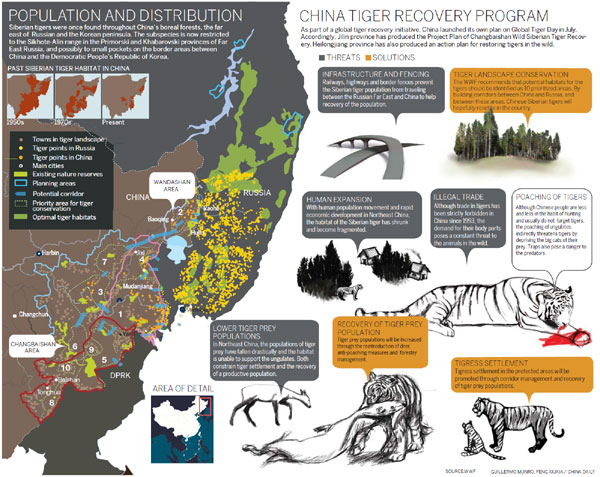Poacher delights in role of forest gamekeeper
Updated: 2012-11-30 07:52
(China Daily)
|
|||||||||||
Former hunter protects endangered species, reports Wu Yong from Suiyang, Heilongjiang province.
Liang Feng'en is a wildlife ranger at the Suiyang Forestry Bureau in southeast Heilongjiang province.
Every day Liang, 55, patrols the mountains on the Russian border as he monitors Siberian tigers, and destroys hidden traps.
 |
"I used to be the best hunter in the region when I retired from the army 30 years ago. But now I look after the animals, including tigers, black bears, roe deer and even squirrels," said the deeply tanned Liang, decked out in green camouflage clothing.
The change came in 2004 when Liang was hired as a wildlife protector. His new role coincided with greater efforts by the authorities to save the environment for wildlife in northeast Asia.
Tigers are native to Asia, with many primarily found in southeastern Russia and northern China. There are eight subspecies and China is home to around 50 wild tigers from four of those subspecies.
Around 20 Siberian tigers and 10 to 20 Bengal tigers live in the Heilongjiang River Basin and the Tibet autonomous region, according to the World Wild Fund for Nature.
Ten Indochinese tigers live in Yunnan province.
South China tigers are believed to be extinct in the wild because there have been no sightings for more than 30 years. Globally, the tiger population has plummeted to 3,200 from more than 40,000 some 30 years ago.
 |
|
Siberian tigers at play at a breeding center in Harbin, the capital of Heilongjiang province. There are now 1,067 Siberian tigers at the base, including 91 newborn cubs. Wang Jianwei / Xinhua |
"The Siberian tiger is more endangered than the giant panda now. It faces extinction without effective protection. And the extinction of this "umbrella species" would be a disaster for the entire ecosystem," said Fan Zhiyong, director of the WWF China's species program.
An umbrella species is one whose survival indirectly protects many other species within its habitat. In China, they include the giant panda, the Siberian tiger and the Asian elephant.
The forest is the most important ecosystem in northeast Asia, according to Fan. Conservation of the Siberian tiger, known in the West as the Amur tiger, is crucial because the animal helps control the region's herbivorous wildlife and preserves the fragile ecobalance between the forests and the grasslands, he added.
"The tiger is the top predator in the food chain. If you protect the tiger, you protect all others in the system," he explained.
Fan is one of the most prominent pioneers of wildlife conservation in China and has been engaged in the work for 30 years. Among his other projects is the construction of a protection zone for the giant panda at the China Conservation and Research Center for the Giant Panda in Wolong, Sichuan province.
The prospects for Siberian tigers appear more promising than those of other subspecies because of the large population in Russia. However, the size of the population means that the tigers have reached saturation point and have started to migrate to northeast China, albeit in small numbers.
As part of the Chinese improvements in wildlife protection, many former loggers and hunters like Liang have now become forest rangers. Their daily work has changed from destruction of the local habitat and wildlife to anti-hunting measures, monitoring movements and raising public awareness of the tigers' plight.
Liang's work is the most basic and important part of tiger protection. Determining the number of big cats in the region and pinpointing their migratory corridors is the cornerstone of the protection plan.
To that end, the WWF has proposed forming nine key areas where tiger settlement units can be built. In addition, the foundation plans to implement a raft of pilot conservation projects, including restoration of the food chain, monitoring and anti-hunting programs, said Zhu Jiang, head of WWF China's Northeast office.
"This way we can gain information about the tigers' living habits and provide technical support for future work," he said.
Early stage research by the WWF has discovered the migration corridors used by the Siberian tigers, which run along the borders of China, Russia and the Democratic People's Republic of Korea.
"The focus of next period of work is to promote the establishment of more reserves and reinforcement of the food chain to attract the animals back," said Zhu.
In a bid to re-establish the food chain, more than 30 red and sika deer were released into the wild in Northeast China's Wangqing Nature Reserve on Global Tiger Day in July.
"To protect animals is to protect ourselves because each life has its own unique meaning for the world. Take the boar (another staple food) for example. The Siberian tiger's food chain would break down without it, and that could put the whole forest at risk," said Liang.
 |
|
A tigeress and cubs in the breeding center. Bai Linhe / for China Daily |
Today's Top News
President Xi confident in recovery from quake
H7N9 update: 104 cases, 21 deaths
Telecom workers restore links
Coal mine blast kills 18 in Jilin
Intl scholarship puts China on the map
More bird flu patients discharged
Gold loses sheen, but still a safe bet
US 'turns blind eye to human rights'
Hot Topics
Lunar probe , China growth forecasts, Emission rules get tougher, China seen through 'colored lens', International board,
Editor's Picks

|

|

|

|

|

|





